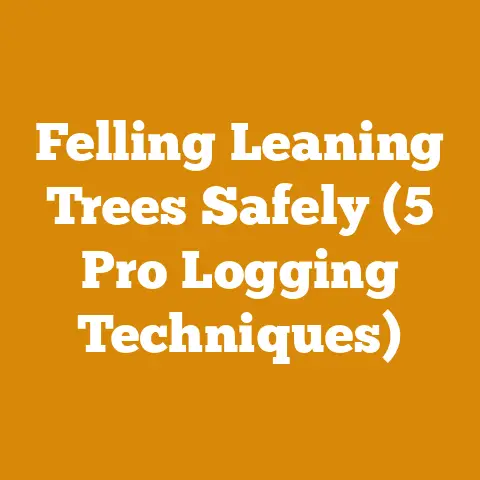Different Jobs in Landscaping: Top Wood Processing Profits (Chainsaw Secrets)
Would you rather spend your weekends sweating buckets, barely making ends meet with back-breaking landscaping tasks, or would you prefer to leverage your skills and equipment to tap into the lucrative world of wood processing? I know what I’d choose! Landscaping is a broad field, but within it lies a goldmine: wood processing. It’s where muscle meets machinery, and a bit of know-how turns trees into treasure. This isn’t just about chopping firewood; it’s about understanding the different jobs in landscaping that lead to top wood processing profits, and unlocking chainsaw secrets that can dramatically improve your efficiency and income.
Different Jobs in Landscaping: Paving the Way to Wood Processing Profits
Let’s be honest, landscaping is more than just mowing lawns. It’s a diverse industry offering multiple avenues, many of which can feed directly into wood processing. Understanding these connections is key to maximizing your earning potential.
Tree Removal: The Starting Point
Tree removal is often the first step. Property owners need trees taken down for various reasons: disease, storm damage, construction, or simply because they’ve outgrown their space. As a landscaper, this is where you come in.
- The Opportunity: Instead of just hauling the wood away as waste (and paying disposal fees!), you can process it. This is where your chainsaw skills and wood-processing knowledge come into play.
- Profit Potential: Let’s say you remove a large oak tree. Disposal costs might be $500. But that same oak, processed into firewood, could yield 2-3 cords, selling for $250-$400 per cord. Suddenly, you’re looking at a potential profit of $250-$700 after covering your costs!
- My Experience: I remember one job where I removed a massive silver maple. The homeowner was just happy to have it gone. I offered a lower price than my competitors because I knew I could recoup some of the cost by processing the wood. I ended up turning that “waste” into a significant profit, and the homeowner got a better deal!
Land Clearing: Big Volume, Big Potential
Land clearing involves removing trees and vegetation to prepare land for construction, development, or agricultural purposes. This is a larger-scale operation than individual tree removal, offering even greater opportunities for wood processing.
- The Opportunity: Large volumes of timber become available. This is perfect for firewood production, but also for milling into lumber, chipping for mulch, or even selling as raw logs to sawmills.
- Profit Potential: Land clearing projects can generate hundreds of cords of wood. Even selling it wholesale to firewood distributors can be highly profitable. Consider this: clearing one acre of moderately wooded land can yield 50-100 cords of wood. At a wholesale price of $100 per cord, that’s $5,000-$10,000 in potential revenue.
- Data Point: According to the USDA Forest Service, land clearing activities contribute significantly to the overall timber supply in many regions. Tapping into this market can be a game-changer for your landscaping business.
- My Insight: I once worked on a land clearing project for a new housing development. The developer was going to burn all the trees! I convinced them to let me process the wood instead. We salvaged enough lumber to build a small shed on the property and sold the remaining firewood. It was a win-win-win: the developer saved money on disposal, I made a profit, and the environment benefited from less burning.
Storm Damage Cleanup: Turning Disaster into Dollars
Unfortunately, storms happen. And when they do, they create a huge demand for tree removal and cleanup services. This is another area where wood processing can boost your profits.
- The Opportunity: Storm-damaged trees are often readily available and relatively inexpensive to acquire.
- Profit Potential: The demand for firewood often spikes after a major storm. People need to heat their homes if the power is out, and they’re often looking for a quick and reliable source of fuel. This allows you to command higher prices for your firewood.
- Safety First: Storm cleanup can be dangerous. Always prioritize safety and wear appropriate protective gear. Be aware of power lines and unstable trees.
- My Experience: After a particularly nasty ice storm, I was swamped with calls for tree removal. I focused on the trees that were easiest to access and process, and I offered a discount to customers who allowed me to keep the wood. I ended up selling out of firewood within a week!
Garden Maintenance: Smaller Scale, Consistent Income
Even routine garden maintenance can provide opportunities for wood processing, albeit on a smaller scale.
- The Opportunity: Pruning trees and shrubs generates smaller pieces of wood that can be chipped for mulch or used for kindling.
- Profit Potential: While the profit margin per job might be lower, the consistent demand for garden maintenance services can provide a steady stream of wood for processing.
- Adding Value: Offering mulch or kindling as an add-on service can increase your revenue and differentiate you from your competitors.
- My Tip: I always keep a small chipper on my truck. It allows me to quickly turn branches and small trees into mulch, which I then sell to my clients for a small profit. It’s a great way to minimize waste and maximize my income.
Chainsaw Secrets: Unlocking Efficiency and Profitability
Your chainsaw is your most important tool in wood processing. Mastering its use and maintenance is crucial for efficiency, safety, and profitability.
Choosing the Right Chainsaw: Matching the Tool to the Task
Not all chainsaws are created equal. Selecting the right chainsaw for the job is essential.
- Small Chainsaws (12-16 inch bar): Ideal for pruning, limbing, and cutting small trees. They’re lightweight and easy to maneuver.
- Medium Chainsaws (16-20 inch bar): Versatile and suitable for a wide range of tasks, including felling small to medium-sized trees, bucking firewood, and general landscaping work.
- Large Chainsaws (20+ inch bar): Designed for felling large trees and handling heavy-duty wood processing. They require more experience and strength to operate safely.
- Electric Chainsaws: Great for small jobs and areas with noise restrictions. They’re quieter and require less maintenance than gas-powered chainsaws.
- Battery-Powered Chainsaws: Offer similar advantages to electric chainsaws but provide greater portability. Battery technology has improved significantly in recent years, making them a viable option for many tasks.
- Data Point: A study by Oregon State University found that using the correct chainsaw size for the task can increase cutting efficiency by up to 20%.
- My Recommendation: If you’re just starting out, a medium-sized chainsaw with a 18-inch bar is a good all-around choice. It’s powerful enough for most jobs but still manageable for beginners.
Chainsaw Maintenance: Keeping Your Saw Running Smoothly
Proper maintenance is essential for extending the life of your chainsaw and ensuring its safe and efficient operation.
- Sharpening the Chain: A dull chain is not only inefficient but also dangerous. Sharpen your chain regularly using a file or a chain grinder. Learn to recognize the signs of a dull chain (e.g., the saw producing sawdust instead of chips, requiring more force to cut).
- Cleaning the Air Filter: A dirty air filter restricts airflow, reducing engine power and potentially damaging the engine. Clean the air filter regularly with compressed air or soap and water.
- Checking the Spark Plug: A faulty spark plug can cause starting problems or poor engine performance. Inspect the spark plug regularly and replace it if necessary.
- Lubricating the Chain: Use bar and chain oil to keep the chain lubricated. This reduces friction, extends the life of the chain and bar, and improves cutting efficiency.
- Checking the Bar: Inspect the bar regularly for wear and damage. Make sure the bar groove is clean and free of debris.
- Storing Your Chainsaw Properly: Store your chainsaw in a dry, safe place. Drain the fuel tank before storing it for extended periods.
- My Tip: I keep a small toolkit with me at all times that includes a chain file, a spark plug wrench, a screwdriver, and a can of bar and chain oil. This allows me to perform basic maintenance on the job site, minimizing downtime.
- Data Point: Regular chainsaw maintenance can extend the life of your saw by up to 50%, saving you money in the long run.
Chainsaw Safety: Protecting Yourself from Injury
Chainsaws are powerful tools that can cause serious injury if used improperly. Always prioritize safety when operating a chainsaw.
- Wear Appropriate Protective Gear: This includes a helmet, safety glasses or a face shield, hearing protection, gloves, chaps, and sturdy boots.
- Read the Owner’s Manual: Familiarize yourself with the chainsaw’s operating instructions and safety precautions.
- Maintain a Safe Working Distance: Keep bystanders at least twice the length of the tree away from the cutting area.
- Be Aware of Kickback: Kickback is a sudden, uncontrolled upward or backward movement of the chainsaw. It can occur when the tip of the bar contacts a solid object or when the chain is pinched. Learn how to avoid kickback by using proper cutting techniques and maintaining a firm grip on the chainsaw.
- Never Cut Above Shoulder Height: Cutting above shoulder height increases the risk of losing control of the chainsaw.
- Avoid Cutting in Unstable Conditions: Do not operate a chainsaw in wet, icy, or windy conditions.
- Take Breaks: Chainsaw work can be physically demanding. Take frequent breaks to avoid fatigue and maintain focus.
- Get Training: Consider taking a chainsaw safety course to learn proper operating techniques and safety procedures.
- My Story: I once witnessed a fellow landscaper suffer a serious injury from kickback. He wasn’t wearing proper protective gear, and he was cutting above shoulder height. It was a painful reminder of the importance of chainsaw safety.
- Data Point: According to the Consumer Product Safety Commission, thousands of people are injured by chainsaws each year. Many of these injuries could be prevented by following proper safety precautions.
Advanced Chainsaw Techniques: Mastering the Art of Cutting
Beyond the basics, mastering advanced chainsaw techniques can significantly improve your efficiency and safety.
- Felling Techniques: Learn proper felling techniques to control the direction of the falling tree and avoid damaging property or injuring yourself. This includes using wedges and ropes to guide the tree’s fall.
- Limbing Techniques: Limbing involves removing branches from a felled tree. Learn how to limb safely and efficiently using various techniques, such as the bore cut and the plunge cut.
- Bucking Techniques: Bucking is the process of cutting a felled tree into smaller, more manageable pieces. Learn how to buck safely and efficiently using various techniques, such as the compression cut and the tension cut.
- Notching: Creating the right notch is crucial for controlling the direction of the fall during tree felling. Different types of notches exist, including the conventional notch, the Humboldt notch, and the open-face notch. Each has its advantages and disadvantages depending on the tree’s size, lean, and surrounding environment.
- Bore Cutting: This technique involves plunging the saw’s tip into the wood to create a cut from the inside out. It’s useful for relieving tension in the wood and preventing pinching of the saw.
- Precision Cutting: Developing the ability to make precise cuts is essential for milling lumber or creating specialty wood products. This requires practice and a good understanding of wood grain and tension.
- My Insight: I spent years honing my chainsaw skills. I learned from experienced loggers and arborists, and I practiced constantly. The more I learned, the more efficient and safer I became.
- Practical Example: When felling a tree leaning in a specific direction, I use a combination of a properly sized notch and wedges to ensure it falls precisely where I want it to. This minimizes the risk of damage to surrounding structures and makes the subsequent processing easier.
Wood Processing Techniques: From Tree to Treasure
Once you’ve acquired the wood, the next step is processing it into a usable product.
Firewood Production: A Reliable Source of Income
Firewood is a consistently in-demand product, especially in colder climates.
- Splitting Wood: Splitting wood can be done manually with a maul or axe, or with a hydraulic log splitter. Log splitters are faster and less strenuous, especially for larger volumes of wood.
- Seasoning Wood: Seasoning wood involves drying it out to reduce its moisture content. This makes it burn more efficiently and reduces the amount of smoke produced. Season wood for at least six months, preferably longer. Stack the wood in a well-ventilated area, off the ground.
- Selling Firewood: You can sell firewood by the cord, half-cord, or smaller bundles. Market your firewood online, through local newspapers, or by word of mouth.
- Wood Species Matters: Different wood species have different burning qualities. Hardwoods like oak, maple, and ash burn hotter and longer than softwoods like pine and fir.
- My Experience: I started selling firewood as a side hustle. I quickly realized that the demand was much greater than I anticipated. I invested in a log splitter and a firewood processor, and my firewood business took off.
- Data Point: A cord of seasoned hardwood can sell for $250-$400, depending on the region and the species of wood.
- Case Study: A small firewood producer in Maine increased their profits by 30% by investing in a firewood processor and improving their seasoning techniques. They also started selling kiln-dried firewood, which commands a higher price.
Lumber Milling: Adding Value to Your Timber
Milling lumber involves cutting logs into boards or other dimensional lumber. This can be done with a portable sawmill or by sending logs to a commercial sawmill.
- Portable Sawmills: Portable sawmills allow you to mill lumber on-site, which can be convenient and cost-effective. They come in various sizes and configurations, from small hobby mills to larger, more productive models.
- Choosing a Sawmill: Consider the size of the logs you’ll be milling, the volume of lumber you need to produce, and your budget when choosing a sawmill.
- Lumber Grading: Learn how to grade lumber according to industry standards. This will allow you to price your lumber accurately and ensure that you’re selling a quality product.
- Drying Lumber: Properly drying lumber is essential to prevent warping, cracking, and other defects. Lumber can be air-dried or kiln-dried.
- My Revelation: I was amazed at how much value you can add to a log by milling it into lumber. A log that might be worth $50 as firewood could be worth hundreds of dollars as lumber.
- Data Point: The price of rough-sawn lumber varies depending on the species, grade, and dimensions, but it is generally significantly higher than the price of firewood.
- Unique Insight: I’ve found that milling lumber from urban trees (trees removed from residential or commercial properties) can be a great way to source unique and valuable wood. These trees often have interesting grain patterns and character that make them highly sought after by woodworkers and furniture makers.
Wood Chipping: Creating Mulch and Biomass Fuel
Wood chipping involves grinding wood into small chips. Wood chips can be used for mulch, landscaping, or as a biomass fuel.
- Chippers: Chippers come in various sizes and configurations, from small homeowner models to large commercial machines.
- Mulch Production: Wood chips make excellent mulch for gardens and landscaping. They help retain moisture, suppress weeds, and improve soil health.
- Biomass Fuel: Wood chips can be burned as a biomass fuel in wood-burning stoves or furnaces.
- My Observation: Wood chipping is a great way to utilize smaller branches and other wood waste that might otherwise be difficult to process.
- Data Point: The demand for wood chips as a biomass fuel is growing as people seek renewable energy sources.
- Practical Tip: I use wood chips from hardwood trees for mulch in my vegetable garden. They decompose slowly and provide a long-lasting source of nutrients for the soil.
Wood Species and Their Properties: Knowing Your Wood
Understanding the properties of different wood species is crucial for successful wood processing.
- Hardwoods vs. Softwoods: Hardwoods are generally denser and more durable than softwoods. They burn hotter and longer, making them ideal for firewood. Softwoods are easier to work with and are often used for construction and furniture making.
- Specific Wood Species:
- Oak: Strong, durable, and rot-resistant. Excellent for firewood, furniture, and flooring.
- Maple: Hard, dense, and has a beautiful grain pattern. Used for furniture, flooring, and musical instruments.
- Ash: Strong, flexible, and shock-resistant. Used for tool handles, baseball bats, and furniture.
- Pine: Soft, lightweight, and easy to work with. Used for construction, furniture, and paper pulp.
- Fir: Similar to pine but slightly stronger and more durable. Used for construction, furniture, and plywood.
- Wood Density: Density affects burning characteristics, workability, and structural integrity. Higher density woods generally burn longer and are stronger.
- Moisture Content: Moisture content significantly impacts wood’s weight, stability, and burning efficiency. Lower moisture content is crucial for firewood and woodworking.
- My Discovery: I learned that different wood species have unique characteristics that make them suitable for different purposes. For example, black locust is incredibly rot-resistant, making it ideal for fence posts and outdoor structures.
- Data Point: The density of wood can vary significantly, ranging from around 20 pounds per cubic foot for balsa wood to over 70 pounds per cubic foot for some hardwoods.
Marketing and Sales: Getting Your Products to Market
Producing high-quality wood products is only half the battle. You also need to market and sell them effectively.
Identifying Your Target Market: Knowing Your Customers
Understanding your target market is essential for developing a successful marketing strategy.
- Firewood: Homeowners, campers, restaurants, and businesses with fireplaces.
- Lumber: Woodworkers, contractors, furniture makers, and homeowners.
- Mulch: Gardeners, landscapers, and homeowners.
- Online Marketing: Create a website or social media page to showcase your products and services. Use search engine optimization (SEO) to improve your website’s ranking in search results.
- Local Advertising: Advertise in local newspapers, magazines, and online directories.
- Word-of-Mouth Marketing: Encourage your customers to spread the word about your business. Offer incentives for referrals.
- Building Relationships: Network with other businesses in the landscaping and construction industries.
- Pricing Strategies: Determine your pricing based on your costs, your competitors’ prices, and the value of your products.
- My Approach: I focus on providing excellent customer service and building long-term relationships with my clients. I also offer a satisfaction guarantee to ensure that my customers are happy with my products and services.
- Data Point: Businesses that invest in marketing and sales tend to grow faster and are more profitable than those that don’t.
Safety Standards and Regulations: Staying Compliant
Adhering to safety standards and regulations is crucial for protecting yourself, your employees, and the environment.
OSHA Regulations: Protecting Workers
The Occupational Safety and Health Administration (OSHA) sets standards for workplace safety. Familiarize yourself with OSHA regulations related to logging, tree care, and wood processing.
Environmental Regulations: Protecting the Environment
Be aware of environmental regulations related to tree removal, wood processing, and waste disposal.
Local Ordinances: Following Local Laws
Check with your local government to ensure that you’re complying with all applicable ordinances related to your business.
Insurance: Protecting Your Business
Obtain adequate insurance coverage to protect your business from liability.
My Commitment:** I am committed to operating my business in a safe and environmentally responsible manner. I always follow all applicable safety standards and regulations.
- Data Point: Businesses that prioritize safety and environmental compliance tend to have lower insurance premiums and fewer accidents.
Conclusion: Turning Landscaping into a Wood Processing Powerhouse
The path to top wood processing profits within the landscaping industry isn’t just about brute force; it’s about strategic thinking, skill development, and a commitment to safety and sustainability. By understanding the different jobs in landscaping that lead to wood processing opportunities, mastering chainsaw techniques, and utilizing efficient wood processing methods, you can unlock a lucrative and rewarding career. Remember, it’s about turning trees into treasure, one carefully processed log at a time. And believe me, with the right knowledge and dedication, you can absolutely make it happen.






